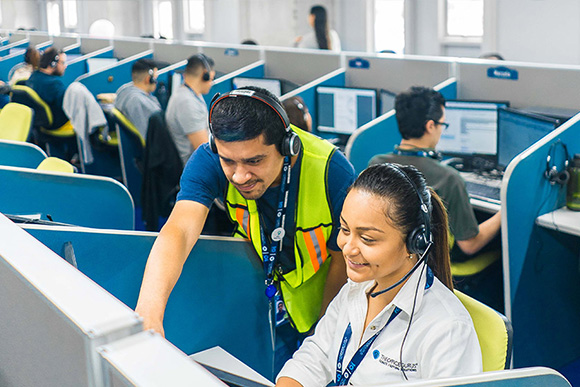We all learned from the COVID-19 crisis that brands can no longer rely exclusively on traditional brick-and-mortar. In the last few months, providers have had to pivot to a work-at-home service platform, adopting a new operational model at breakneck speed. While this was a challenge for the industry, it gave rise to a more robust form of service offering that is guaranteed to weather any storm.
In order to provide progressive, innovative, reliable, and secure solutions, BPOs now need to be able to offer customers hybrid service models that effectively leverage the benefits of both virtual and in-center teams. This hybrid approach represents the most reliable choice for business continuity/disaster recovery, making it an essential practice for the success of any contact center outsourcing initiative.
Here are some of the benefits and essential elements of a robust hybrid model and how they play a part in business continuity:
Collaboration, Training, and Technology
Most traditional in-center agent development approaches simply don’t work under a virtual model, especially when it comes to training, performance management, and employee engagement, so the success of a hybrid model relies heavily on the quality of your collaboration tools and how you leverage them.Platforms like Microsoft Teams—one of our multiple choices—give all agents the ability to chat in real-time, hold face-to-face meetings, screen share, and participate in daily huddles, which are all essential for employee morale, engagement, development, and team building. On top of that, we arrange non-work hangouts and team lunches, emulating the social aspects of the traditional contact center environment.
From the perspective of coaching, it is important to have the ability to monitor the agent’s voice interactions and computer screens, both in-center and at home. With the right collaborative tools, you can take over an agent’s desktop, share screens, and seamlessly emulate in-center training techniques.
For example, as part of the nesting or shadowing process, these tools enable experienced agents to handle the voice part of the call while trainees simultaneously input data or navigate things on the desktop. In place of having the ability to look over each other’s shoulders, it’s now possible to have a trainee in Belize listening to the call and working in the system, while a coach in El Salvador watches how the trainee handles the screen navigation element.
Building a successful hybrid model requires an equal level of dedication to both virtual and traditional teams, with no one left behind—it is essential that everyone feels part of the same team, no matter their location. By implementing the right technology and committing to 100% inclusion, the risks associated with silo’d, isolated teams become virtually non-existent.
Dispersed Teams and Leadership
From a leadership perspective, a successful hybrid model offers a lot of flexibility in terms of matching your best leaders with the best opportunities.With dispersed teams, it becomes possible to pick and choose the best leaders for any given client-partner from any location. For instance, a qualified supervisor in El Salvador can manage a virtual team in Florida. Clients are no longer limited to one location and can benefit from having the best possible managers supervising their teams.
Furthermore, with one management team dedicated to the work-at-home workforce, you can ensure consistency in coaching, communication, and management techniques. Ultimately, the most robust business continuity and disaster recovery plan available is a brick-and-mortar team in one location and a dispersed work-at-home team all working with the same technology, performance management structure, and management philosophy.
Future-Proof Recruitment and Engagement
Hiring, onboarding, and engaging with agents is an entirely different process within a hybrid model.The ability to hire work-at-home employees opens up the recruitment pipeline immensely. The candidate sourcing process is no longer limited to the area around the call center, as work-at-home provides access to people all over the country—and even the broader nearshore region. It also becomes easier to recruit agents with specific skills, qualifications, or professional backgrounds, regardless of where they are based.
That said, agents need to confirm that they are capable and willing to work from home. Not every agent is well suited to work-at-home, so seeking out specific attributes like self-motivation, strong time management skills, and a high comfort level with the required hardware and software. From an infrastructure standpoint, work-at-home agents need a secure, private workspace where they can concentrate, and should agree to regular internet speed tests to ensure their network speed meets the necessary requirements.
Once the work-at-home setup is in place and stable, companies need to ensure their virtual agents never are left behind. One idea is to send out rechargeable gift cards, or use delivery services to send food and gifts to people’s homes. These little touches really help to establish that in-center feeling at home and keep employees feeling like part of the team.
With sales accounts, the traditional approach involves marking sales on a whiteboard and applauding each success. In a hybrid model, you need to leverage gamification and systems like an intranet site that includes leaderboards, chat functions, agent profiles, and virtual sales boards that include comments, emoji, and other ways for people to celebrate wins together. These tools help everybody to track team performance and motivate people to achieve and exceed both their team goals and personal ones, wherever they are.
Final Thoughts
Before work-at-home became essential, the main options for business continuity in nearshore contact center outsourcing were to either temporarily transfer agents to another brick-and-mortar center—or in some cases another country—or attempt to train different teams to handle campaigns.Coordinating these efforts takes a lot of time - weeks in some cases. The process involves selecting suitable agents for transfer, waiting for them to decide whether to go, transporting them to and from different centers, and training additional agents to cover any service drop off during this transitional period. Even with a well-planned approach, this will always result in major service disruption.
In the event of another COVID-level disaster, agents either need to be able to transition to work-at-home seamlessly with no disruption in service or already working at home. The only way to achieve either of those solutions is with a hybrid model.
Quite simply, even with multiple centers in several countries brick-and-mortar companies without a hybrid option represent the highest risk for contact center outsourcing buyers, so don’t settle for anything less than hybrid.


 Dominic Leide is the President of The Office Gurus and has over 20 years of experience in the BPO / Call Center industry. Dominic has led The Office Gurus from a 50 seat captive call and contact center to a global provider of BPO solutions with 5 call centers in 4 different countries. Dominic is an active member of the Young President’s Organization and has taken part in call center panels on a variety of topics. In his free time his passions include boating with his family and coaching as many youth sports as possible!
Dominic Leide is the President of The Office Gurus and has over 20 years of experience in the BPO / Call Center industry. Dominic has led The Office Gurus from a 50 seat captive call and contact center to a global provider of BPO solutions with 5 call centers in 4 different countries. Dominic is an active member of the Young President’s Organization and has taken part in call center panels on a variety of topics. In his free time his passions include boating with his family and coaching as many youth sports as possible!



